You are using an out of date browser. It may not display this or other websites correctly.
You should upgrade or use an alternative browser.
You should upgrade or use an alternative browser.
Violectric V590
- Added by project86
- Create date
project86
Headphoneus Supremus
Pros: Exceptional sound, drives any headphones well, robust build, plenty of inputs/outputs, no weak links as many do-it-all devices have
Cons: Not cheap, not available in silver (as far as I know, for the moment at least)
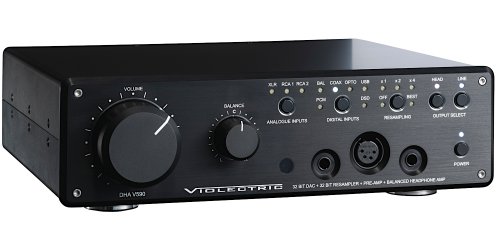
At this point, I don't feel the need to make long-winded introductions about the Violectric brand. I've written extensively about their gear over the past decade, along with their more studio oriented Lake People gear and now the ultra-high-end Niimbus imprint. Most readers have a good handle on the history and pedigree involved, so I'll cut right to the chase on this one.
The V590 is Violectric's latest flagship. It's a true all-in-one DAC, headphone amp, and preamplifier, with equal attention given to all three aspects. This deviates from prior Violectric models where the headphone amp was the main attraction and the optional (and relatively low cost) DAC add-on was nowhere near the same caliber. Conversely, other mainstream devices (Benchmark, Mytek, Antelope Audio, etc), to my ears at least, give the DAC top billing whilst the headphone out is more of a bonus feature for the sake of convenience. But the new Violectric V590 is a true all-around performer.
To set the scene: Violectric designed the amplifier portion of V590 as a successor to the legendary V281. This means at some point down the line a stand-alone version will no doubt become available, but I don't have any further details regarding their time frame. In any case, this is a balanced, discrete design with all the typical Violectric talking points: massive power reserves, high internal operating voltage, low output impedance, and low noise. This amp is potent enough to drive any headphones with ease (5 full Watts at 50 ohms) while being quiet enough to synergize with sensitive IEMs (V590 has 8dB less noise than V281).

The DAC section was built from the ground up specifically for the V590. I don't know what the company has planned for a future stand-alone version, but I wouldn't be surprised to see that happen - the performance is certainly high enough to justify it. The design is based around dual-mono AKM DAC chips along with AKM's exceptional 32-bit resampler which also acts as the digital audio receiver for incoming signals. The Amanero Combo384 handles USB signals which then route to the resampler as well. Front panel controls give us several options for resampling including the ability to disable it completely. A Femtoclock ties the whole operation together with utmost precision.
Note that while designer Fried Reim has been notably critical of DSD audio in the past, and had thus far stubbornly refused to implement DSD capabilities in his prior devices, he nonetheless relented and made V590 capable of playing up to quad rate DSD (the specs indicate it goes higher to DSD512 but I have not tried). This is a long overdue update in my humble opinion. While it's true that the vast majority of music is only available in standard CD quality PCM, we still want the ability to play hi-res PCM as needed - I can't imagine Fried releasing a DAC limited to 16-bit/44.1KHz. Similarly, even though many of the "DSD" releases are just glorified/upconverted PCM, there does remain a small amount of superb "real" DSD recordings to be enjoyed. Fried may still be critical of the merits of the DSD format but it's always a good idea to let the users decide for themselves. And at this point, most DAC chips and USB implementations have that functionality on board anyway, so why not?
The standard V590 configuration ($3499) involves a motorized Alps pot, allowing the very nice bundled remote to adjust volume, select inputs and outputs, and most everything else which has a front panel control. You do have to set the pre-gain and line-out gain manually around back using the traditional Violectric DIP-switches, but that's more of a set-and-forget situation. An additional $599 gets us the "Pro" configuration which replaces the Alps pot with a 256-step reed-relay solution similar to the one found in the mighty Niimbus US4+. My review unit came with the Pro configuration so I can't really speak to how it contributes to the sonics compared to a stock build.
As for pre-amp capabilities, V590 has a pair each of RCA and XLR connections on both the input and output sections. Add in the digital inputs (USB, AES, coax, and optical) and most folks likely have enough connectivity for their entire rig. At one point I paired V590 with a music server via USB, a CD transport via AES, a warm gooey tube DAC (to give an alternate take on the presentation) via analog XLR in, and still had a set of RCA inputs remaining for connecting a turntable if I wanted to go that route. I then used the RCA outputs to feed a warm gooey tube headphone amp (again, for variety) whilst tapping the XLR outputs for my speaker amp. It's certainly possible that someone would need even more connectivity, but for the majority of users V590 is likely to be enough.
In terms of sound, my initial concern was how much of an upgrade the V590 amp section might be over the already excellent Violectric V281 amplifier. Way back when the V590 first arrived, I posted my initial impressions in the main V590 thread, and honestly my opinion has only solidified since then. After spending many hours listening and comparing back to back, I would say V590 amp section offers something of a mixture between the V281 sound and the Niimbus US4+ signature.0
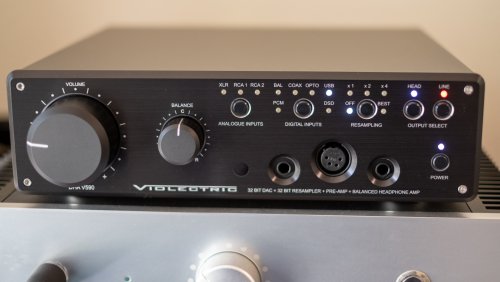
While evaluating the amp section, I used my reference DAC - the Resonessence Mirus Pro Signature - feeding V590 via Audio Art XLR cables. This was fed by a Euphony Audio Summus music server by way of a BMC PureUSB1 active cable. Audio Art supplied all interconnects and AC cables, and headphones included a wide range of models such as LCD-4, Susvara, Utopia, HD650, Elex, K812, Kennerton Thekk, Empyrean, and various others which I'm probably forgetting.
The general Violectric "house sound" (for all their gear but particularly the higher-end headphone amplifiers) involves rich tonality, huge dynamics, superb low frequency slam which is also very controlled, a suitably wide and deep soundstage which is set back somewhat from the front row, and a wonderfully balanced treble response that walks the line between smoothness and detail retrieval. I'd say the V590 continues that same tradition but moves slightly closer to the Niimbus sound: more focus on top end refinement and clarity, slightly less bass slam yet more texture and nuance down there, superior imaging, and faster transient response. It could still be considered just a touch on the warm side, particularly so if compared to something like the headphone out of a Chord or Benchmark product, but I'd call it generally more neutral then the V281 overall.

The V590 amp stage has enough grunt to make even the mighty Susvara sound exceptional. Is it on par with the Niimbus US4+ or a good speaker amplifier? Not quite. But it is, without a doubt, the best I've heard Susvara sound from an all-in-one device. Ditto various other difficult loads like HE-6. Dynamics are astounding and bass punch is palpable, while treble remains totally controlled - three areas which usually expose poor matches on these challenging headphones. Meanwhile sensitive headphones have no trouble in terms of noise - V590 is practically silent, and the pre-gain settings work wonders for optimal pairing with a variety of sources. As I type, I'm listening to the AME Radioso custom IEM via my classic Toxic Cables balanced silver/gold cable, and there's not a hint of background noise or hiss to be found. I do use a balanced power conditioner and I know that contributes to a lower-noise experience, but I've got many other devices here which aren't as quiet as the V590. So obviously Violectric is doing something right. Perhaps some uber-sensitive IEMs may bring out more hiss but in my (fairly extensive) collection I'm just not having any issues.
I also need to mention how much I love the reed relay volume control, a $599 upgrade over the standard version. It is very similar to the design used in the Niimbus US4+, which I've always maintained is the best volume control I've yet to encounter on an audio product. It just feels "right" to me. Having 256 volume increments is vastly superior to most stepped attenuators out there using 24 steps (Burson, Cayin), 36 steps (Bottlehead), or 48 steps (Wells Audio) - with so many steps in such small increments, I'm able to dial in just the right levels regardless of my headphone choice. Operation is practically silent, unlike the V281 stepped attenuator option which produced audible clicks that bothered some people (I never minded it). I can't say for sure how much the sound changes when going from the relay option to the standard Alps volume solution, as I have not heard that version. With V281 it was a small but noticeable difference, and I imagine the superior reed relay design plus the general increase in resolving capability on this device would lead to a more substantial improvement, but I am obviously speculating here.
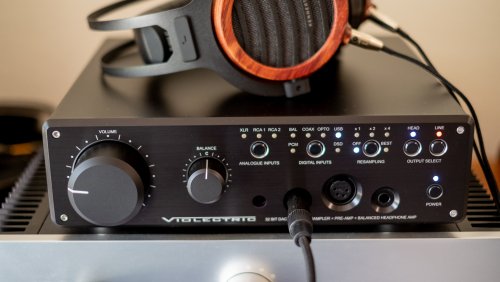
Swapping in various sources to evaluate how the V590 amp responds to changes proved illuminating. This amp section is more responsive than its predecessor, with the ability to showcase the best and worst aspects of upstream gear. The punchy, dynamic Wyred4Sound 10th Anniversary DAC. The lush analog sound of the ModWright UDP-205. The intense yet slightly overcooked tonality of my aging SimAudio Moon Orbiter universal player. The effortless realism of the Sonnet Morpheus. V590's incisive amp section exposes the true character of each DAC or player with minimal editorializing of its own, save perhaps for a hint of (welcome) warmth. Repeating this experiment with V281 just doesn't capture the same amount of variation from one source to the next.
Overall the amplifier section feels like a very sensible evolution of the existing Violectric presentation, without going so far as to abandon the core appeal. Anyone reading the above and thinking the V590 might be too thin or analytical has nothing to worry about. This is still a meaty, rich, textured amplifier that will bring out all the authority a headphone can muster. It won't turn an HD800 into an Empyrean, but rather will give the Sennheiser a fighting chance for those on the fence about its spartan presentation. I am particularly enamored with how fast, open, and holographic it sounds - attributes I encounter more often with brighter, more caffeinated sound signatures. Experiencing them combined with such a rich tonality is very satisfying.

Moving on to the DAC portion. I fed it through the same Euphony Summus music server, and isolated it by using XLR outputs to the Niimbus US4+ headphone amplifier. I later swapped in my Nativ Vita music server in order to investigate differences between digital inputs, since the Vita offers a wide array of connectivity options (spoiler: V590 doesn't have much variation at all, meaning USB is very well sorted). Again I listened with a variety of headphones and music to give the DAC a real workout.
The DAC section lays a great foundation for the integrated amplifier but also pairs quite well with any external amp one might use. It's clear, highly resolving, and has a bit of sweetness to it which keeps it from becoming too analytical. This midrange sweetness - actually the entire presentation if I really think about it - reminds me of the Yulong DA10, which is one of my absolute favorite DACs in the sub-$2k category. Both are based around AKM chips but of course there are many other factors involved, and I have plenty of other devices with AKM chips that sound completely different.
Bass is weighty but not boosted. Texture and clarity seem to be the main focus, and are sufficient to give the impression of excellent authority. Using the Niimbus US4+ is a great way to highlight any shortcomings one might hear in the low-end of a DAC, and it has sometimes exposed weaknesses that I had not heard when using lesser amplification. The V590 has no such problems.
Treble is superbly balanced - accurate, very detailed, but also very slightly laid back in comparison to some of my other DACs. It's not what I'd call "soft", nor does the DAC veer into "dark" territory in the least. The focus is just more on textural flow than transient attack and extended decay trails. This DAC seems meant for listening enjoyment rather than gawking at obscure details. So while it does dig plenty deep into the mix, that doesn't quite seem like the main focus. Still, if we look back to the older Violectric V800 and V850 products - both known for their neutrality and resolution - this new DAC digs deeper while at the same time flowing more smoothly. So ultimately this is still a generally neutral component.
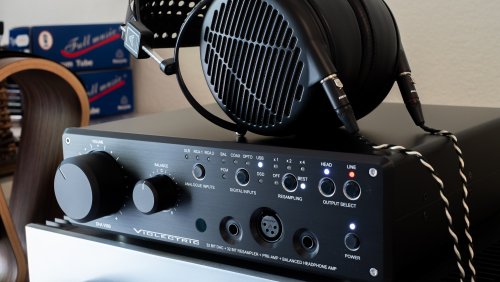
Playing with the resampling options gives us subtle variations to the resulting sound. The differences are small, and at times almost impossible to notice, but in the right situation I do hear changes. This is noteworthy since V590 does not allow users to cycle through DAC filters as some products do - but these resampling options seem to make a larger difference anyway. My general impression is that higher sample rates (particularly x4) bring a sensation of more treble energy and top-end air. This is occasionally welcome, such as when dealing with dull recordings or darker headphones, so it's nice to have the option. I generally leave resampling set to "best" and call it a day though. Choosing "off" disables resampling altogether, which to my ears is usually not a desirable choice as it makes the system far more dependent on transport quality. With a top-caliber transport, the difference between "off" and "x1" is essentially zero, but with most associated gear you'll want to keep some form of resampling engaged.
As much as I love the improved amplifier section, the ground-up V590 DAC sometimes feels like the star of the show. Unlike most integrated DACs, it doesn't feel like a weak link at all. Synergy with the integrated headphone stage is absurdly good, with the signatures playing extremely well together. In short, only the finest external DACs will offer any significant improvement over what V590 has built in.
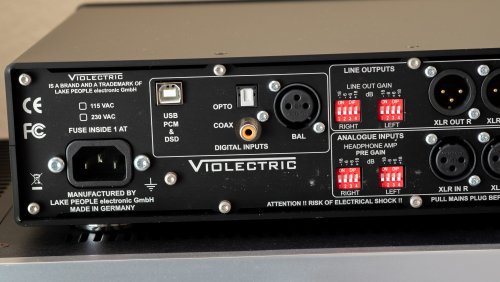

Lastly, the preamp section. I spent less time there versus the headphone amp and DAC section, as I just don't spend much time with my speaker rig these days. But from my somewhat limited experience I can say that it feels generally on par with the rest of the V590. The extensive inputs and useful remote (included with base model and Pro configurations) make this a more realistic option than, say, the Pass Labs HPA-1, which is by all accounts sonically amazing but also extremely minimalistic in terms of features. My system includes Merrill Audio Thor monoblocks and Usher Mini One Diamond speakers, and using V590 as preamp easily fits in the same class as the old Jeff Rowland and Krell units I have laying around. The V590 as preamp is neutral, dynamic, refined, and has that sense of "drive" which seems to characterize better preamplifiers. While going direct from DAC to amp can often lead to a sort of stark, bleached signature (particularly with already thin-sounding products such as Benchmark), V590 performs on the level of a true high-end preamplifier.
In the end, it's obvious that I'm enamored with the Violectric V590 and its superb performance. Whether used as a DAC, headphone amplifier, preamp, or any combination of the three, V590 is nothing less than brilliant. Faced with the difficult task of updating their classic V281, Violectric really nailed it, going above and beyond with the new DAC section as well. Those who only need a DAC or stand-alone headphone amplifier should obviously wait for the company to launch them as individual separates... but for anyone who might find an integrated solution useful, V590 earns my highest recommendation.
Sound Quality
Thank you @project86 for your amazing review on both the V590 and Niimbus. They are both fantastically written and full of helpful information for those researching.
In this review you mention, 'This is still a meaty, rich, textured amplifier that will bring out all the authority a headphone can muster'. In the Niimbus review when comparing to the V281 you mention, 'The basic presentation is definitely from the same family - robust, textured low end performance, weighty tonal balance, precise imaging, stunningly clear mids, and delicately balanced treble'.
I have a neutral sounding RME DAC and the HD 800 S. If money was no object and you had to pick between the V550 and Niimbus, which one would you go for?
In this review you mention, 'This is still a meaty, rich, textured amplifier that will bring out all the authority a headphone can muster'. In the Niimbus review when comparing to the V281 you mention, 'The basic presentation is definitely from the same family - robust, textured low end performance, weighty tonal balance, precise imaging, stunningly clear mids, and delicately balanced treble'.
I have a neutral sounding RME DAC and the HD 800 S. If money was no object and you had to pick between the V550 and Niimbus, which one would you go for?
project86
That's a tough question due to the way the question is phrased. In general terms, I would usually choose the Niimbus hands down. But with an RME DAC and an HD800S, the slightly more relaxed presentation of the V550 (and V590 but you get the point) may be more sonically pleasing. True, the Niimbus would be more honest, but that's not always what most people truly want to hear (myself included at times).
So if you want really high resolution, brutally honest sound, RME plus HD800S plus Niimbus would do the trick. For a slightly more forgiving sound that still has excellent clarity but is perhaps more palatable with a wider variety of music including poor recordings, the V550 might get the nod. If that makes sense. You are sacrificing some ultimate fidelity or honesty and that may be a good thing (or not).
So if you want really high resolution, brutally honest sound, RME plus HD800S plus Niimbus would do the trick. For a slightly more forgiving sound that still has excellent clarity but is perhaps more palatable with a wider variety of music including poor recordings, the V550 might get the nod. If that makes sense. You are sacrificing some ultimate fidelity or honesty and that may be a good thing (or not).


I am coming from lower-mid tier Monolith THX-AAA DAC/AMP which is really decent. Spending 8-12times the price I expect the level of improvement to be at-least double. What I expect is neutral DAC-AMP combo which would be precise and detailed having good separation and sound stage with perfect imaging.
Initially I was recommended Mytek Liberty THX-AAA AMP. For which I needed dedicated DAC but was my only option. Then I checked out the Mytek other offerings. Brooklyn Line had only one analog input. Mytek Manhattan was looking good as it had 3 x analog inputs and was All in one. Heard that on board amp on Manhattan II was as good as V280 from some one on this forum. I was eagerly waiting for upcoming Manhattan but then I came across V590 which is equally good on fulfilling my input requirements. Now all comes down to which will perform better.